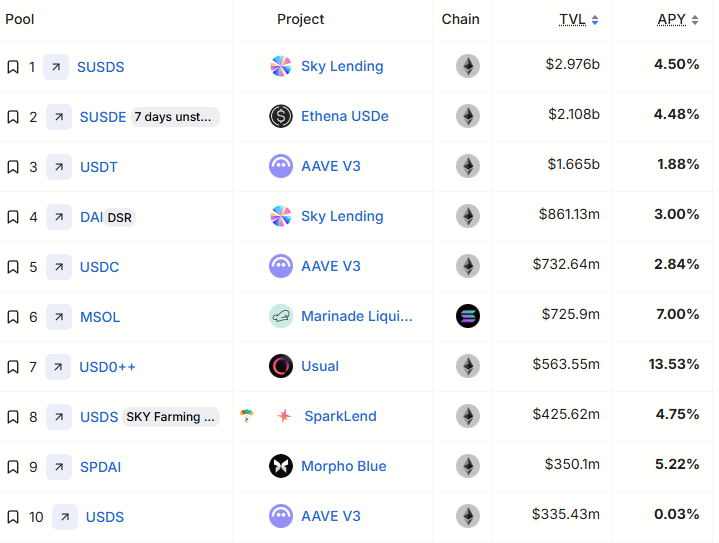Although the altcoin market capitalization has not yet returned to its previous peak, the stablecoin market capitalization is setting new records in 2025, currently exceeding $240 billion. Investors are seeking ways to optimize returns in a high-volatility environment without immediately allocating capital.
Stablecoin yield protocols are emerging as a major option in 2025. Analysts have presented strong arguments, and the topic of stablecoin yields is gaining increasing attention in the crypto community.
Signs of Stablecoin Yield Wave
One of the clearest indications of increasing interest in stablecoin yields is the recent moves by major industry players.
Ledger, a popular hardware wallet provider, announced on April 29, 2025, that they have integrated stablecoin yield functionality into the Ledger Live app.
With this update, users can earn up to 9.9% annual percentage yield on stablecoins like USDT, USDC, USDS, and Dai. Users maintain full custody of their assets. To date, Ledger has sold over 7 million hardware wallets.
PayPal has also joined this competition. The company now offers a 3.7% annual percentage yield on the PYUSD stablecoin. After the SEC's investigation into PYUSD, PayPal currently faces no major regulatory obstacles in expanding its stablecoin initiatives.
Furthermore, according to defillama data, there are over 2,300 stablecoin pools across 469 protocols and 106 blockchains. This indicates a significant increase in demand for yield opportunities through stablecoins.

According to the data, the total value locked in the top 10 stablecoin pools ranges from $335 million to over $2.9 billion. These pools can offer annual percentage yields of up to 13.5%.
While many investors are waiting for the altcoin season to recover portfolio losses, the current momentum points to a "stablecoin season" driven by attractive yields.
Stablecoin Yields: An Investor Trend?
GC Cooke, CEO and founder of Brava, confirmed the key reasons why investors are turning to stablecoins to find yields.
He argues that unpredictable policy changes are causing ripple effects across the market. Traditionally "safe" stocks are experiencing sharp fluctuations based on a single headline. He believes moving from stocks to yield-generating assets like stablecoin yields is a way to avoid the risk of dramatic stock price drops.
Traditionally, bonds were the go-to yield asset.
— GC Cooke (@GCcookeHQ) April 29, 2025
But in our current market, something more innovative has emerged: stablecoin yields.
These crypto assets maintain stable value (typically pegged to the dollar) while generating returns that outperform traditional fixed income. pic.twitter.com/gqcvyz5pMd
Chuck, a builder at Paxos, mentioned that as regulatory frameworks for stablecoins become clearer in the US, EU, Singapore, and UAE, yield integration will become easier.
As a result, stablecoin wallets could evolve into personal financial hubs, eliminating the need for traditional banks.
"[Stablecoin] wallets can receive salaries. Issue a card linked to stablecoin balances that can be spent directly without converting to fiat. Enable P2P payments globally. Provide yields through tokenized money markets. This continues the existing trend: wallets becoming financial hubs — no bank branches needed," Chuck said.
But What Are the Risks?
Despite the optimism, there are notable risks in the stablecoin yield market.
Analyst Wazahat Mughal pointed out that fewer than 10 stablecoins have a market capitalization of over $1 billion. Most stablecoins still have a market cap below $100 million.
Some protocols offer high APYs. Teller provides yields of 28%–49% on USDC pools. Yearn Finance, founded by Andre Cronje, offers over 70% APY on CRV pools. Fx-protocol and Napier offer 22%–30% APY on RUSD and EUSDE respectively. However, these high yields often come with significant risks.
Choze, a research analyst at Amagi, highlighted several concerns. Many pools still have low total value locked between $10,000 and $120,000, indicating these strategies are in early stages and can be highly volatile.
Some rewards depend on ecosystem tokens. Strategies often involve multiple protocols, adding complexity. He warned investors to pay attention to the long-term growth of each project's ecosystem.
"Opportunities do exist, especially for those who know how to explore small emerging farms. However, it is important to understand what is actually being farmed, including not only stable returns but also ecosystem growth and early-stage incentives." – Choze said.
Investors may face risks such as stablecoin lending or staking platforms being hacked, vulnerabilities being exploited, or experiencing technical defects. This can lead to loss of funds. Some algorithm-based or low-credibility stablecoins may also lose their peg to the dollar.
Nevertheless, the role of stablecoins is undeniably growing. With attractive yields and strong real-world payment use cases, they are changing the way investors participate in the cryptocurrency market.
This opens up new ways to generate returns without relying solely on the next altcoin season.




